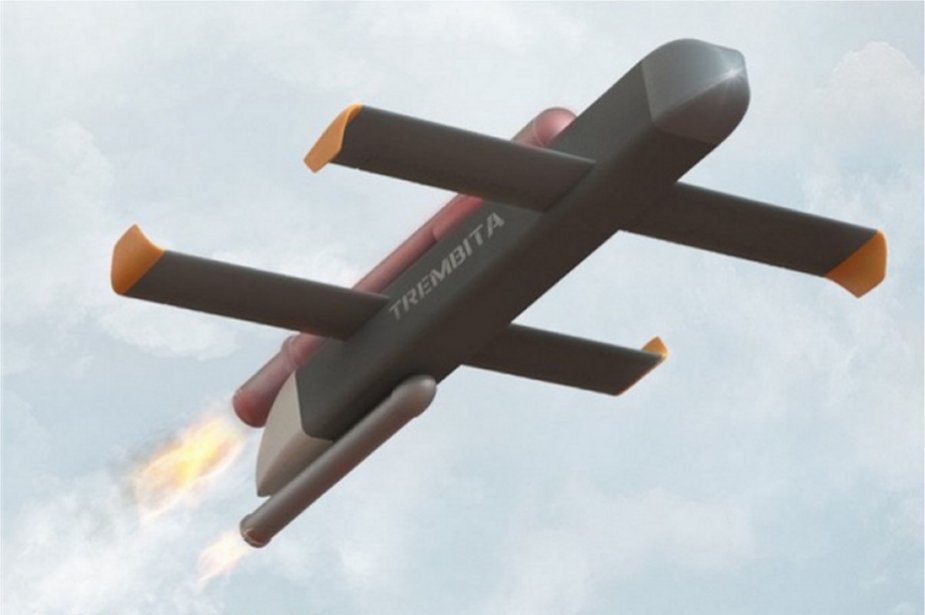- Army
- Conflicts in the world
- Israel - Iran conflict 2025
- Pakistan - India Conflict 2025
- Russia Ukraine War 2022
- Libya conflict day by day
- HAMAS - Israel War 2023
- Operation Serval in Mali French Army
- Sangaris operation Central African Republic
- Sangaris opération militaire République Centreafrique
- Ukraine - Russia conflict
- Syria conflict news
- Defence & Security Industry Technology
- Armies in the world
- Analysis Defense and Security Industry
- Conflicts in the world
- Navy
- Air
Ukraine's homegrown cruise missile Trembita ready to challenge Russian defenses
According to a France24 article on July 30, 2023, Ukrainian volunteers have successfully developed an affordable surface-to-surface cruise missile known as Trembita, aimed at overpowering Russian air defenses. It represents Ukraine's first domestically developed cruise missile and has earned the nickname "people's missile."
Follow Army Recognition on Google News at this link

Trembita takes flight as Ukraine's first homegrown surface-to-surface cruise missile (Picture source ZN.UA)
The Trembita is a Ukrainian surface-to-surface cruise missile named after the long wooden alpine horn played by Ukrainian shepherds. The project was initiated by a group of volunteers who were dedicated to enhancing their country's defense capabilities.
Akym Kleymenov serves as the project's chief engineer, and Viktor Romaniuk, a former member of Ukraine's parliament, organized the effort. The research and development team consists of eight full-time members and has been involved in the construction of drones and a new type of mortar with a highly accurate targeting system, in addition to the missile.
The Trembita missile is known for its cost-effectiveness, with an estimated construction cost of around $3,000, making it a competitive alternative to modern counterparts. By investing approximately $7,000 more, the missile can be equipped with modern navigation systems, further enhancing its effectiveness. In comparison to Russia's Kinzhal and Kalibr hypersonic missiles, which have a significantly higher price tag of $1 million to $2 million each, the Trembita project offers a more economical solution without compromising its potential impact.
The missile comes with several capabilities that make it a valuable asset in Ukraine's defense arsenal. Weighing 100 kg and featuring an armored casing, it has the capacity to carry a 20 kg warhead, which may consist of a thermobaric charge or a combined high-explosive charge. With an operational range of 140 km and a top speed exceeding 400 km/h, it offers flexibility in engaging targets at varying distances. Additionally, the missile can reach flight altitudes ranging from 30 meters to 2000 meters, allowing it to be suitable for diverse combat scenarios.
The Trembita missile is powered by a jet pulse engine and carries 30 liters of fuel, utilizing diesel or petrol for easy access to fuel from local sources. Moreover, the absence of moving parts in the propulsion system simplifies manufacturing and maintenance processes, contributing to its cost-effectiveness. Its compact size allows for easy transportation, fitting into a car boot, and it can be launched using a pneumatic catapult or solid-fuel booster, providing deployment flexibility for Ukraine's defense forces.
To support the mass production of the Trembita, Viktor Romaniuk envisions strategic crowdfunding. The plan is to produce up to 1,000 limited-range cruise missiles each month, at an estimated cost of $350,000 to $600,000.
Developers of the Trembita have set up their own mini-production line, making use of faulty Ukrainian Grad missiles and captured Russian Grads as a source of valuable missile fuel accelerant.
The missile's strategy revolves around launching 20 to 30 missiles simultaneously to challenge and overcome Russian air defenses, thereby increasing the accuracy of Ukrainian attack rockets. Some of these missiles may not carry explosives, adding complexity to the defense environment and making it harder for adversaries to distinguish real threats. Targets will include ammunition dumps, command and control centers, among others.
It is believed that the deployment of the Trembita missile carries a psychological impact on Russian soldiers due to the deafening 100dB noise it produces, which could potentially contribute to the success of military operations. Further tests are scheduled to take place at a military training base, and volunteers from different regions in Ukraine have expressed interest in assisting with the production of Trembita missiles in multiple locations.


























